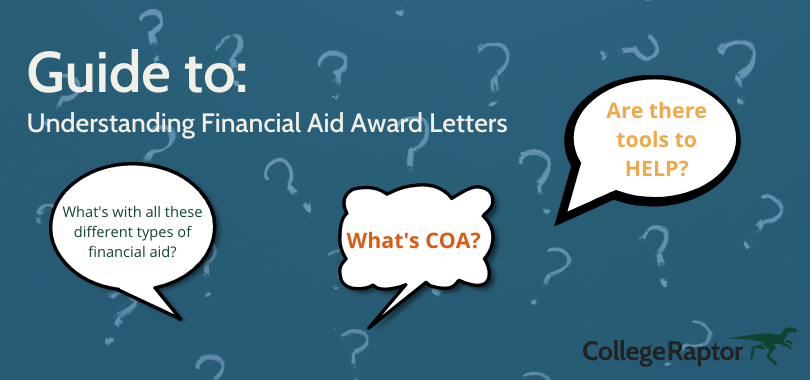Once a college accepts your application, the first thing they do is to put together a customized offer letter. These offer letters contains all information about financial aid awards the school is willing to offer you. Understanding the different components of each offer letter is key to being able to make an informed decision about which college you want to attend.

Breaking Down Your College Offer Letters
When you submit your FAFSA (Free Application for Federal Student Aid) application, it is forwarded to all the colleges listed on the form. Colleges use this information to calculate how much aid you are eligible to receive. Every school has its own set of criteria for awarding financial aid.
Your college offer letter will include details regarding:
Cost of Attendance (COA)
The COA will be stated clearly in an offer letter. This is an estimate of what you can expect to pay for one academic year in college. It includes the cost of tuition, room and board, books and supplies, transportation, fees, and personal expenses.

Expected Family Contribution (EFC)
Your EFC is what the government thinks your family can afford to pay from savings, loans, and other assets towards college costs. Colleges use this number to calculate how much financial aid you are eligible for. It’s important to understand that this is not how much your family will actually have to pay. The EFC is determined only for the purpose of calculating financial aid eligibility.
College Grants
Grants are a type of financial aid that may be offered by the school, your state or the federal government. Grants are need-based and do not have to be paid back.
College Scholarships
College scholarships may be awarded by your school or any private organization. These may be based on merit, need or interest. Every funding institution sets their own eligibility criteria. Any award money you win does not have to be paid back.
Federal Work-Study
If you are eligible for work-study, you can take up a job on or off campus to earn your financial aid. The money you earn goes towards living and school-related expenses. Each school allow students to work a set amount of hours a week.
Federal Student Loans
Federal student loans are a form of financial aid offered by the federal government. The free financial aid is rarely enough to cover the total cost of college, especially in private universities. Federal student loans are low-interest loans that help you cover the outstanding costs. Your college offer letter will state the maximum amount you are eligible to borrow. Whatever you borrow has to be paid back with interest.
Additional Financial Aid Details
Along with details regarding aid amounts, your offer letter will also include these financial aid details:
- The loan terms and conditions such as interest rates, loan term and fees
- Whether the loan is subsidized or unsubsidized
- Any requirements you need to maintain eligibility such as minimum GPA or specific number of course credits
- The process for accepting or declining aid
- The deadline for accepting the offered aid
- The academic period for which the aid is offered
- How and when the aid will be disbursed
- What happens after the first year with regards to the various types of financial aid
- Additional documentation that you need to submit
- The school’s policy on external scholarship awards
Why You Should Compare Letters
Comparing the college offer letters you receive is crucial. Simply comparing the total amount of aid offered by each school is not enough. After all, the cost of attendance might not be the same, so the aid may not carry the same weight.
The goal is determining what you’re offered and the net price to attend that school.
You must read each offer letter thoroughly and calculate how much it will cost you to attend each school. Add up all the free aid the school is offering by way of grants, scholarships and work-study. Then calculate the maximum amount you can borrow by way of federal student loans. If the cost of attendance is much higher than the aid offered, you’ll have to take out private student loans to cover the remaining costs. These loans are very expensive and can increase the cost of tuition dramatically. You have to decide whether it’s really worth it to take on so much student loan debt to attend that particular college.
Calculating the COA for each college will help you make your final college decision.
Easily Compare with Our College Offer Letters Tool
Manually comparing multiple offer letters can be frustrating. Especially since colleges will format their letters differently. Fortunately, there is an easy solution. College Raptor recently launched a brand-new, totally free comparison tool!
Upload your offer letters and we’ll do the hard work of parsing out the most important information. You’ll be able to compare costs, aid amounts, and potential debt side by side with ease.
Why Award Amounts Might Be Different
It’s not surprising that award amounts differ from one college to another. Every school has their own policy for accepting students and for calculating and awarding financial aid. As a general rule, private colleges tend to offer better financial aid packages. But because their cost of tuition is also higher, you still end up paying more than what you’d pay to attend an in-state college.
If you’ve got your heart set on attending a particular college but it costs more than you can afford, don’t be afraid to appeal the award. Some colleges may reconsider and offer you a better package if they have the funds.
| Lender | Rates (APR) | Eligibility | |
|---|---|---|---|
 |
5.50%-16.12%* Variable
3.99%-15.61%* Fixed
|
Undergraduate and Graduate
|
VISIT CITIZENS |
 |
5.54% - 15.70% Variable
3.99% - 15.49% Fixed
|
Undergraduate and Graduate
|
VISIT SALLIE MAE |
 |
4.63% - 17.99% Variable
3.49% - 17.99% Fixed
|
Undergraduate and Graduate
|
VISIT CREDIBLE |
 |
6.00% - 13.75% Variable
3.99% - 13.75% Fixed
|
Undergraduate and Graduate
|
VISIT LENDKEY |
 |
5.66% - 14.72% Variable
3.69% - 14.56% Fixed
|
Undergraduate and Graduate
|
VISIT ASCENT |
 |
3.70% - 8.75% Fixed
|
Undergraduate and Graduate
|
VISIT ISL |
 |
5.62% - 16.85% Variable
3.69% - 16.49% Fixed
|
Undergraduate and Graduate
|
VISIT EARNEST |
 |
5.00% - 14.22% Variable
3.69% - 14.22% Fixed
|
Undergraduate and Graduate
|
VISIT ELFI |





